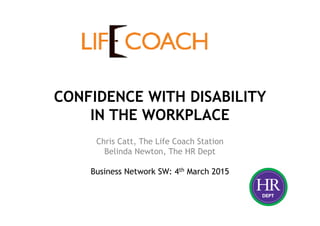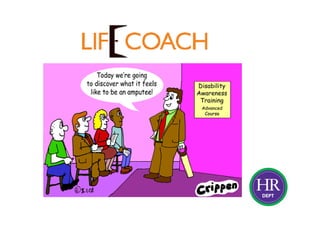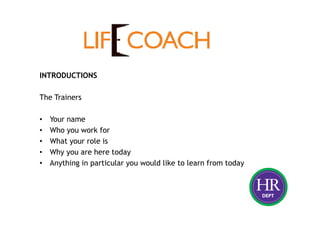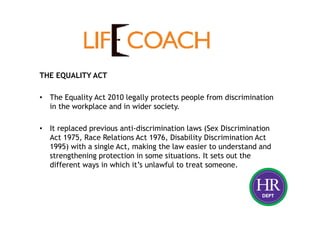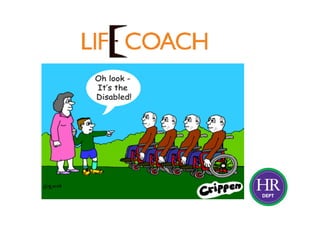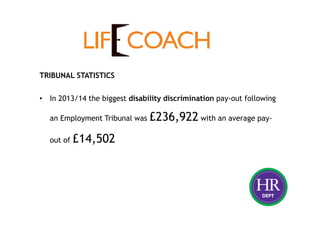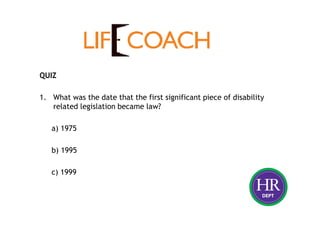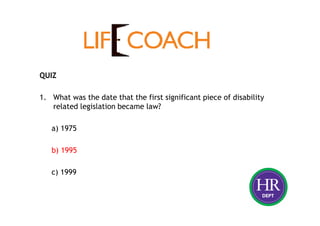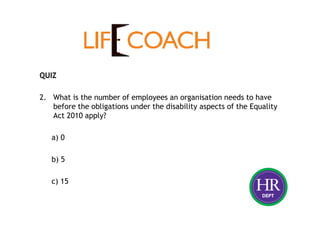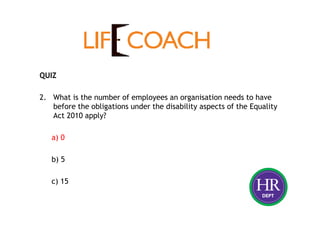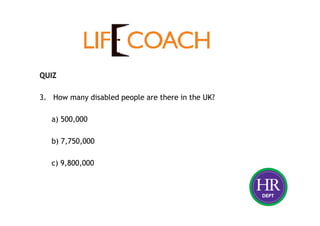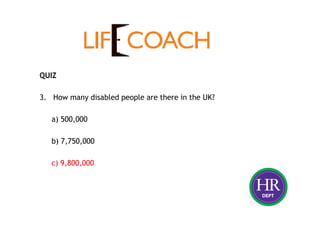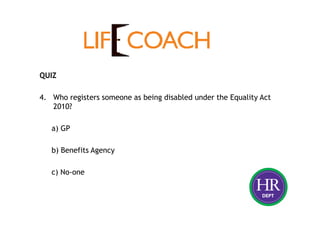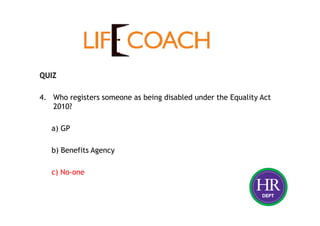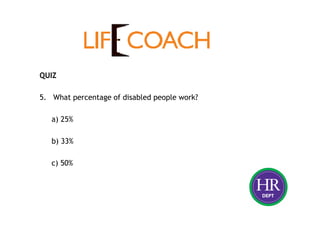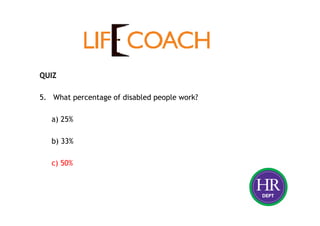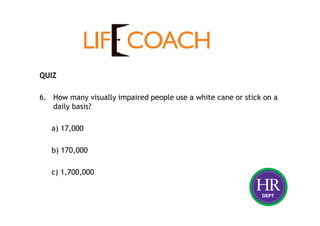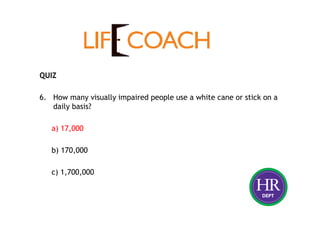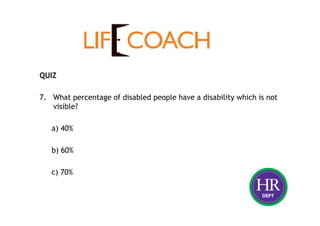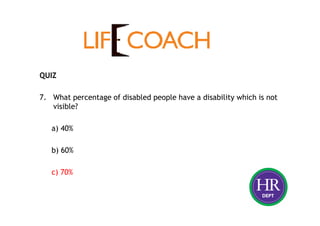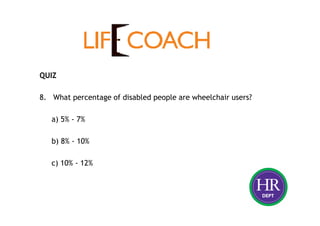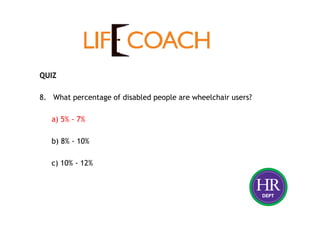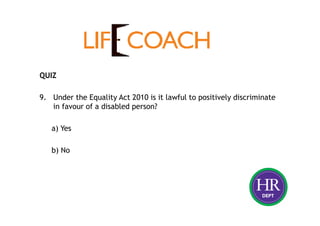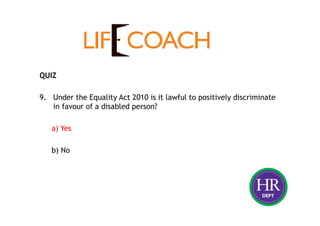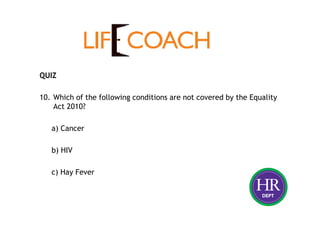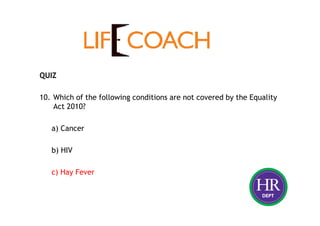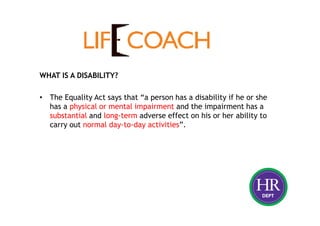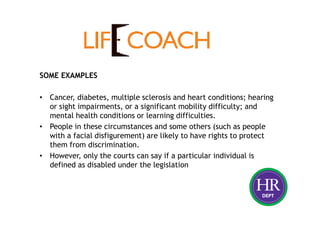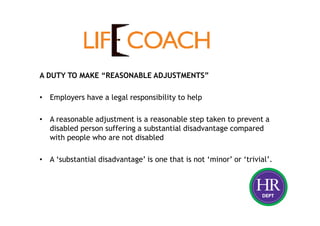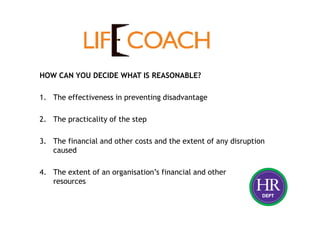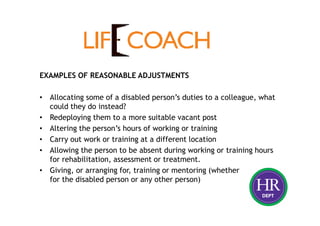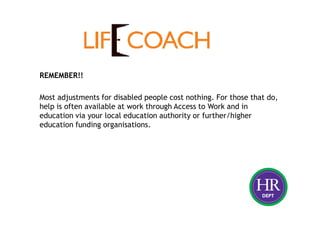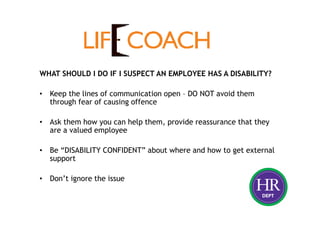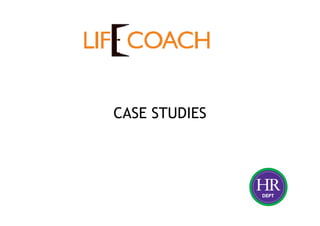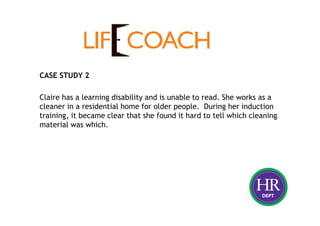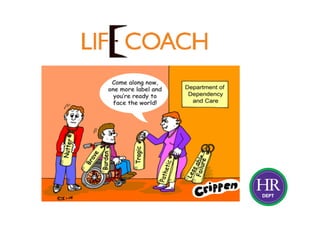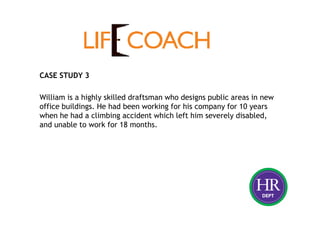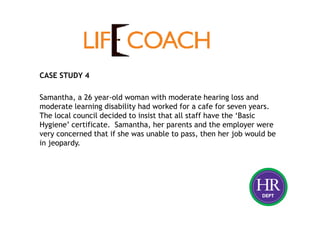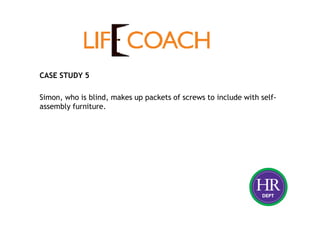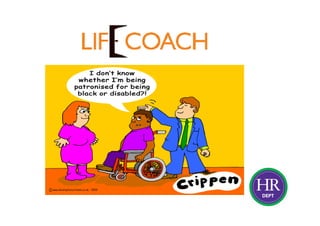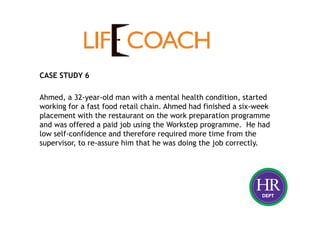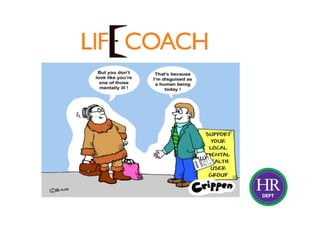Disability Confidence - Exeter Business Network March 2015
- 1. CONFIDENCE WITH DISABILITY IN THE WORKPLACE Chris Catt, The Life Coach Station Belinda Newton, The HR Dept Business Network SW: 4th March 2015
- 3. INTRODUCTIONS The Trainers âĒ Your name âĒ Who you work for âĒ What your role is âĒ Why you are here today âĒ Anything in particular you would like to learn from today
- 4. THE EQUALITY ACT âĒ The Equality Act 2010 legally protects people from discrimination in the workplace and in wider society. âĒ It replaced previous anti-discrimination laws (Sex Discrimination Act 1975, Race Relations Act 1976, Disability Discrimination Act 1995) with a single Act, making the law easier to understand and strengthening protection in some situations. It sets out the different ways in which itâs unlawful to treat someone.
- 6. TRIBUNAL STATISTICS âĒ In 2013/14 the biggest disability discrimination pay-out following an Employment Tribunal was ÂĢ236,922 with an average pay- out of ÂĢ14,502
- 7. QUIZ 1. What was the date that the first significant piece of disability related legislation became law? a) 1975 b) 1995 c) 1999
- 8. QUIZ 1. What was the date that the first significant piece of disability related legislation became law? a) 1975 b) 1995 c) 1999
- 9. QUIZ 2. What is the number of employees an organisation needs to have before the obligations under the disability aspects of the Equality Act 2010 apply? a) 0 b) 5 c) 15
- 10. QUIZ 2. What is the number of employees an organisation needs to have before the obligations under the disability aspects of the Equality Act 2010 apply? a) 0 b) 5 c) 15
- 11. QUIZ 3. How many disabled people are there in the UK? a) 500,000 b) 7,750,000 c) 9,800,000
- 12. QUIZ 3. How many disabled people are there in the UK? a) 500,000 b) 7,750,000 c) 9,800,000
- 13. QUIZ 4. Who registers someone as being disabled under the Equality Act 2010? a) GP b) Benefits Agency c) No-one
- 14. QUIZ 4. Who registers someone as being disabled under the Equality Act 2010? a) GP b) Benefits Agency c) No-one
- 15. QUIZ 5. What percentage of disabled people work? a) 25% b) 33% c) 50%
- 16. QUIZ 5. What percentage of disabled people work? a) 25% b) 33% c) 50%
- 17. QUIZ 6. How many visually impaired people use a white cane or stick on a daily basis? a) 17,000 b) 170,000 c) 1,700,000
- 18. QUIZ 6. How many visually impaired people use a white cane or stick on a daily basis? a) 17,000 b) 170,000 c) 1,700,000
- 19. QUIZ 7. What percentage of disabled people have a disability which is not visible? a) 40% b) 60% c) 70%
- 20. QUIZ 7. What percentage of disabled people have a disability which is not visible? a) 40% b) 60% c) 70%
- 21. QUIZ 8. What percentage of disabled people are wheelchair users? a) 5% - 7% b) 8% - 10% c) 10% - 12%
- 22. QUIZ 8. What percentage of disabled people are wheelchair users? a) 5% - 7% b) 8% - 10% c) 10% - 12%
- 23. QUIZ 9. Under the Equality Act 2010 is it lawful to positively discriminate in favour of a disabled person? a) Yes b) No
- 24. QUIZ 9. Under the Equality Act 2010 is it lawful to positively discriminate in favour of a disabled person? a) Yes b) No
- 25. QUIZ 10. Which of the following conditions are not covered by the Equality Act 2010? a) Cancer b) HIV c) Hay Fever
- 26. QUIZ 10. Which of the following conditions are not covered by the Equality Act 2010? a) Cancer b) HIV c) Hay Fever
- 27. WHAT IS A DISABILITY? âĒ The Equality Act says that âa person has a disability if he or she has a physical or mental impairment and the impairment has a substantial and long-term adverse effect on his or her ability to carry out normal day-to-day activitiesâ.
- 28. SOME EXAMPLES âĒ Cancer, diabetes, multiple sclerosis and heart conditions; hearing or sight impairments, or a significant mobility difficulty; and mental health conditions or learning difficulties. âĒ People in these circumstances and some others (such as people with a facial disfigurement) are likely to have rights to protect them from discrimination. âĒ However, only the courts can say if a particular individual is defined as disabled under the legislation
- 29. A DUTY TO MAKE âREASONABLE ADJUSTMENTSâ âĒ Employers have a legal responsibility to help âĒ A reasonable adjustment is a reasonable step taken to prevent a disabled person suffering a substantial disadvantage compared with people who are not disabled âĒ A âsubstantial disadvantageâ is one that is not âminorâ or âtrivialâ.
- 30. HOW CAN YOU DECIDE WHAT IS REASONABLE? 1. The effectiveness in preventing disadvantage 2. The practicality of the step 3. The financial and other costs and the extent of any disruption caused 4. The extent of an organisationâs financial and other resources
- 31. EXAMPLES OF REASONABLE ADJUSTMENTS âĒ Allocating some of a disabled personâs duties to a colleague, what could they do instead? âĒ Redeploying them to a more suitable vacant post âĒ Altering the personâs hours of working or training âĒ Carry out work or training at a different location âĒ Allowing the person to be absent during working or training hours for rehabilitation, assessment or treatment. âĒ Giving, or arranging for, training or mentoring (whether for the disabled person or any other person)
- 32. REMEMBER!! Most adjustments for disabled people cost nothing. For those that do, help is often available at work through Access to Work and in education via your local education authority or further/higher education funding organisations.
- 34. WHAT SHOULD I DO IF I SUSPECT AN EMPLOYEE HAS A DISABILITY? âĒ Keep the lines of communication open â DO NOT avoid them through fear of causing offence âĒ Ask them how you can help them, provide reassurance that they are a valued employee âĒ Be âDISABILITY CONFIDENTâ about where and how to get external support âĒ Donât ignore the issue
- 35. CASE STUDIES
- 36. CASE STUDY 1 Maria has restricted vision and works as a receptionist in a social services department. Every month she attends a departmental meeting in a room away from her workstation. The minutes of the meeting are usually printed in 12-point type, which Maria cannot read without her desktop magnification aids.
- 38. CASE STUDY 2 Claire has a learning disability and is unable to read. She works as a cleaner in a residential home for older people. During her induction training, it became clear that she found it hard to tell which cleaning material was which.
- 40. CASE STUDY 3 William is a highly skilled draftsman who designs public areas in new office buildings. He had been working for his company for 10 years when he had a climbing accident which left him severely disabled, and unable to work for 18 months.
- 42. CASE STUDY 4 Samantha, a 26 year-old woman with moderate hearing loss and moderate learning disability had worked for a cafe for seven years. The local council decided to insist that all staff have the âBasic Hygieneâ certificate. Samantha, her parents and the employer were very concerned that if she was unable to pass, then her job would be in jeopardy.
- 44. CASE STUDY 5 Simon, who is blind, makes up packets of screws to include with self- assembly furniture.
- 46. CASE STUDY 6 Ahmed, a 32-year-old man with a mental health condition, started working for a fast food retail chain. Ahmed had finished a six-week placement with the restaurant on the work preparation programme and was offered a paid job using the Workstep programme. He had low self-confidence and therefore required more time from the supervisor, to re-assure him that he was doing the job correctly.
- 48. ?

